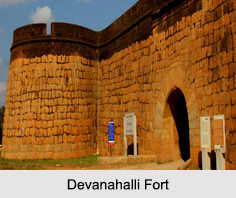 Devanahalli Fort is situated at Devanahalli, towards the north Bengaluru, in the district of Bangalore Rural in the state of Karnataka. It is located on National Highway 7 near Bengaluru International Airport. The structure was constructed by Malla Baire Gowda in 1501. The fortress was occupied by his descendants till the middle of the 18th century. Later Nanjarajaiah, the then Dalwai or ruler of the Kingdom of Mysore, attacked the fort and successfully seized the structure. Eventually Devanahalli Fort came under the control of Hyder Ali and later under Tipu Sultan of Mysore. During the Third Mysore War, the army of British East India Company under the leadership of Lord Cornwallis besieged the fortress and later occupied it in 1791. The birthplace of the ruler of Mysore, Tipu Sultan, is situated close to Devanahalli Fort. Presently, the structure has been declared as a protected monument. It is maintained by the Archaeological Survey of India (ASI).
Devanahalli Fort is situated at Devanahalli, towards the north Bengaluru, in the district of Bangalore Rural in the state of Karnataka. It is located on National Highway 7 near Bengaluru International Airport. The structure was constructed by Malla Baire Gowda in 1501. The fortress was occupied by his descendants till the middle of the 18th century. Later Nanjarajaiah, the then Dalwai or ruler of the Kingdom of Mysore, attacked the fort and successfully seized the structure. Eventually Devanahalli Fort came under the control of Hyder Ali and later under Tipu Sultan of Mysore. During the Third Mysore War, the army of British East India Company under the leadership of Lord Cornwallis besieged the fortress and later occupied it in 1791. The birthplace of the ruler of Mysore, Tipu Sultan, is situated close to Devanahalli Fort. Presently, the structure has been declared as a protected monument. It is maintained by the Archaeological Survey of India (ASI).
History of Devanahalli Fort
Malla Baire Gowda, the son of Rana Baire Gowda of the Morasu Wokkalu family, established the regions of Devanahalli, Dodda Ballapura and Chikka Ballapura. The region of Devanahalli was included as part of Gangawadi. However later it came under the reign of the rulers of Rashatrakuta Dynasty, Nolamba rulers, Hoysala Empire, Chola Dynasty, Pallava Dynasty and the rulers of the Vijayanagar Empire.
During the reign of the Vijayanagar Emperors, Malla Baire Gowda initially built a mud fort at Devanadoddi (Devanahalli) in 1501 AD, with the support of Devaraya. Later, under the instruction of Nanja Raja, it was occupied by the Wodeyars of Mysore in 1747 AD. The Devanahalli Fort was occupied several times by different rulers from different empires, such as the Maratha rulers, Haider Ali and Tipu Sultan of Mysore. The fortress was re-built with stone during the rule of Haidar Ali and Tipu Sultan. Eventually during the Third Mysore War, armed forces of British East India Company seized the fort in 1791, under the command of Lord Cornwallis.
Architecture of Devanahalli Fort
The Devanahalli Fort covers a total area of 20 acres and is entirely built of stone. The fortification towards the east of the fort is oval shaped and is covered with decorated masonry. It includes twelve semi-circular bastions located at regular intervals. In the interior part of the fortification, a large battlement is located. The entrances in the west and the east of the fort are adorned with plasterwork. The bastions include gun points that were constructed with brick and lime.
There are several temples located inside the premise of the fortress. One of the oldest temples of Devanahalli Fort is the Venugopalaswamy temple. The temple includes a spacious courtyard which has a Garuda Stamba. The temple walls display several scenes from the epic Ramayana and various legends of Lord Krishna. Various types of statues are carved on the pillars of the temple. The Garbhagriha includes a statue of Venugopala in a standing posture. The Navaranga has four pillars built with black stones. These include carvings of fine relief sculptures.
The Siddalingeshwara temple is also located inside the fort. The other temples in the vicinity are Raghavendraswamy Math, Sarovaranjaneya temple and Chandramouleshwara Temple. The Nanjundeshwara temple is also located in the vicinity. It is a small structure and contains two cells and a navaranga. It was formerly known as Kashi Vishveshwara.
Visiting Information on Devanahalli Fort
The nearest railway station is the Devanahalli station located at a mere distance of 600 m and the Kempegowda International Airport in Bengaluru is about 14 km away from the fort.



















